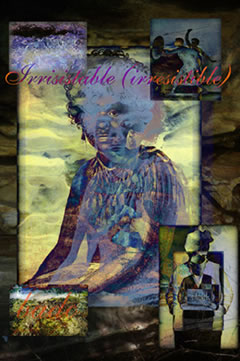Stills on Campus - Pinhole to Pixel
Exhibition: 29 May to 30 June, 2001

© Copyright: Brenda Croft
The first of three collaborative exhibitions between Stills gallery and The Sir Hermann Black Gallery at the University of Sydney
As early as the 10th century AD the principle of the camera obscura was described. It was discovered that a darkened room (a camera obscura in Latin) with a small hole in one wall allowing light to enter could produce an inverted image on the opposite wall.The idea of capturing that image took hold and eventually, centuries later, gave birth to photography. In 2001 many photographic artists sit in darkened rooms in front of glowing computer screens and labour away at their images - able to manipulate the information down to the level of the pixel - the basic picture element. In this exhibition, the first of 3 to be held in conjunction with the Sir Hermann Black Gallery at the University of Sydney, Stills Gallery invites you to explore the range of artworks and techniques - from pinhole to pixel - employed by artists currently working with photography.
Pinhole to Pixel comprises the work of 18 talented and diverse artists. Artists like Peter Callas, Phil George, Brenda L Croft, Robyn Stacey and Merilyn Fairskye use sophisticated digital techniques to combine images and create new realities. Their images are often highly coloured, intensely detailed and large scale. Liu Xiao Xian and Lili Almog begin with a largely 'straight' photographic image and alter it digitally, in both cases manipulating the face and identity of the photographic subject. Pat Brassington's source images are either her own black and white photos or found images - these are then subtly coloured, duplicated or altered in the computer to create pleasing and perverse works.
Also featured in Pinhole to Pixel are artists using the original method of combining and creating images. With great imagination and dexterity artists like George Schwarz and Peter Lyssiotis create and combine picture elements with scalpels and glue, a technique which has almost been replaced by the computer. Christine Cornish draws on her painting background to create the lines, textures and shapes in her photographs before and during the film exposure, rather than with a computer.
For Rebecca Cummins, the lens and it's role in imaging is a source of great fascination - as can be evidenced in Birds Eye View - her periscope birdbath installation. Rebecca Shanahan uses the effects of the elements on her negatives to explore the veracity and reliability of the photographic record. Eugenia Raskopoulos paints with light - using the photographic paper as if it is a page to be drawn upon. The methods employed in this exhibition also include some of the earliest photographic techniques including Anne Ferran's haunting photograms of womens clothing, Stephanie Valentin's shadowgrams of plants, Ruby Davies pinhole photographs taken along the Darling River and Harry Nankin's fragments from The Wave - where the water, seaweed and sand have been allowed to make their impression directly onto the photographic emulsion.
We hope the images in Pinhole to Pixel will take you beyond this focus on technique to entrance and seduce you into a pleasurable - emotional - aesthetic and cerebral engagement.
